Red Devil Cichlid Amphilophus Labiatus Size Around : A Captivating South American Cichlid for a Thriving and Visually Appealing Aquarium, Easy Care for New Aquarists and Experienced Keepers
£14.99 Original price was: £14.99.£12.57Current price is: £12.57.
Welcome the stunning Red Devil Cichlid Amphilophus Labiatus into your aquarium! This vibrant South American Cichlid showcases beautiful red coloration, making it a captivating centerpiece for any fish tank. Perfect for aquarists seeking vibrant, flourishing aquatic environments.
1963 in stock
Species Introduction
The Red Devil Cichlid, scientifically known as Amphilophus labiatus, is a captivating freshwater fish that originates from the lakes and rivers of Central America, particularly Nicaragua and Costa Rica. This species is renowned for its striking appearance and vibrant colors, which can range from bright orange to deep red, often with a beautiful sheen that catches the light in any aquarium setting. As a member of the Cichlidae family, the Red Devil Cichlid is characterized by its robust body, pronounced nuchal hump, and aggressive demeanor, especially during breeding seasons. These fish thrive in warm, well-oxygenated waters with ample hiding spots, making them a popular choice for aquarists looking to create a dynamic and visually appealing aquarium.
Essential Care Guide
| Optimal Living Conditions | |
|---|---|
| Water Temperature | 24-27°C (75-81°F) |
| pH Level | 6.5-7.5 |
| Water Hardness | 4-12 dKH |
| Minimum Tank Size | 80L (20 gal) |
| Salinity | Freshwater |
| Care Level | Beginner Friendly |
Natural Behavior & Temperament
The Red Devil Cichlid is known for its bold and aggressive temperament, particularly during breeding seasons. These fish exhibit territorial behavior, often establishing a dominant presence in their aquarium. They are known to be highly intelligent and can recognize their keepers, often displaying curiosity and interaction. In a community tank, it is essential to choose tank mates wisely, as their aggressive nature can lead to conflicts with smaller or less assertive species. However, when kept in a suitable environment with proper tank mates, Red Devil Cichlids can exhibit fascinating social behaviors, such as forming bonds with their companions and displaying courtship rituals.
Tank Setup Guide
Creating an optimal tank environment for Red Devil Cichlids involves careful consideration of substrate, decorations, and hiding spots. A sandy or rocky substrate mimics their natural habitat and allows for digging and burrowing behaviors. Incorporating caves, driftwood, and large rocks can provide essential hiding spots and territories, reducing stress and aggression among tank mates. It is also crucial to ensure that the decorations are securely placed to prevent them from being overturned during territorial disputes. Additionally, providing ample swimming space is vital, as these fish are active swimmers. A well-planted aquarium can enhance the aesthetic appeal while offering natural cover for shy or smaller fish. Proper filtration is essential to maintain water quality, as these fish can produce significant waste.
Water Quality Management
Maintaining optimal water quality is paramount for the health and well-being of Red Devil Cichlids. Regular water testing is essential to monitor pH, ammonia, nitrite, and nitrate levels. The ideal pH range for these fish is between 6.5 and 8.0, with stable levels being crucial to prevent stress. Temperature should be maintained between 75°F to 82°F, with a heater used to ensure consistency. Water hardness should be kept between 10 to 20 dGH, providing a suitable environment for these freshwater fish. Regular water changes of 20-30% weekly can help maintain water quality, reducing the buildup of harmful toxins and ensuring a healthy habitat for your aquatic companions. Additionally, utilizing a high-quality filtration system will aid in keeping the water clean and clear.
Feeding & Nutrition
✓ Feeding Schedule: 2-3 times daily
Diet: High-quality cichlid pellets, frozen or live foods
Red Devil Cichlids are omnivorous and thrive on a varied diet that includes high-quality cichlid pellets, frozen foods such as bloodworms and brine shrimp, and occasional live foods. It is essential to provide a balanced diet to ensure optimal growth and coloration. Feeding should occur 2-3 times daily, with portions that can be consumed within a few minutes to prevent overfeeding and maintain water quality. It is also beneficial to incorporate vegetable matter, such as blanched spinach or spirulina, to enhance their nutritional intake. Monitoring their feeding habits will help you gauge their health and adjust their diet accordingly.
Compatibility Guide
⚠ Important Notice: Avoid small or passive fish
When selecting tank mates for Red Devil Cichlids, careful consideration is essential due to their aggressive nature. Suitable companions include larger, more robust cichlids such as Oscars or Jack Dempseys, as well as other fish that can hold their own, like larger barbs or certain species of catfish. It is crucial to avoid smaller or more passive fish, as they may become targets for aggression. Additionally, providing ample hiding spots and territories will help reduce conflicts and establish a more harmonious community tank.
Health & Wellness
Maintaining the health and wellness of Red Devil Cichlids involves regular monitoring for signs of illness and stress. Common health issues include ich, fin rot, and swim bladder disorders, which can arise from poor water quality or stress. Regular water changes and maintaining stable water parameters are essential for preventing these issues. Observing your fish for signs of distress, such as lethargy, loss of appetite, or unusual swimming patterns, can help in early detection of health problems. In the event of illness, prompt treatment with appropriate medications and adjustments to their environment can aid in recovery. Additionally, ensuring a balanced diet and providing a stress-free environment will contribute to their overall health.
Breeding Information
Breeding Red Devil Cichlids can be a rewarding experience for aquarists. These fish are substrate spawners, meaning they lay their eggs on a flat surface, often in caves or on smooth rocks. To encourage breeding, it is essential to provide a suitable environment with appropriate hiding spots and stable water conditions. The female typically lays hundreds of eggs, which the male will fertilize. After hatching, the fry will remain close to their parents for protection. It is crucial to monitor the breeding pair during this time, as they can become aggressive towards other tank mates. Once the fry are free-swimming, they can be fed with finely crushed flakes or specialized fry food. Separating the fry into a separate tank can help ensure their survival and growth.
Acclimation Process
Introducing a Red Devil Cichlid to a new aquarium requires careful acclimation to minimize stress and ensure a smooth transition. Begin by floating the sealed bag containing the fish in the aquarium for about 15-20 minutes to equalize the temperature. After this, gradually mix small amounts of the aquarium water into the bag over the next hour, allowing the fish to adjust to the new water parameters. Once acclimated, gently release the fish into the aquarium, avoiding the introduction of bag water to prevent contamination. Monitoring the fish closely during the first few days in their new home is essential to ensure they adapt well and display normal behavior.
Long-term Care
Long-term care of Red Devil Cichlids involves understanding their growth expectations and lifespan. These fish can grow up to 12 inches in length and require a spacious tank to accommodate their size. Providing a stable environment with consistent water quality, a balanced diet, and regular health monitoring will contribute to their longevity. With proper care, Red Devil Cichlids can live for 10-15 years in captivity. Regularly reassessing their tank setup and making necessary adjustments will ensure they thrive throughout their lives.
Natural Habitat Recreation
Recreating the natural habitat of Red Devil Cichlids in your aquarium involves mimicking their environment found in Central America. This includes using sandy substrates, large rocks, and driftwood to create hiding spots and territories. Incorporating live plants can enhance the aesthetic appeal while providing natural cover. However, it is essential to choose hardy plant species that can withstand the cichlid’s digging behavior. Maintaining stable water conditions that reflect their natural habitat will contribute to their overall health and well-being. Utilizing a well-designed aquascape will not only benefit the fish but also create a visually stunning display in your home.
Seasonal Care Adjustments
Seasonal changes can impact the care of Red Devil Cichlids, particularly in relation to temperature and lighting. During the warmer months, it may be necessary to monitor the water temperature closely to prevent overheating, while in colder months, heaters should be adjusted to maintain the ideal temperature range. Additionally, adjusting the lighting schedule to mimic natural day-night cycles can promote healthy behaviors and reduce stress. Observing your fish during seasonal changes will provide insights into their needs and help ensure their continued health and happiness.
Expert Tips
For aquarists looking to provide the best care for their Red Devil Cichlids, consider implementing the following expert tips: 1) Regularly test water parameters to ensure stability and prevent stress. 2) Provide a varied diet to promote health and vibrant coloration. 3) Monitor tank dynamics closely, especially during breeding periods, to prevent aggression. 4) Create a visually appealing aquascape that mimics their natural habitat, enhancing their well-being and your enjoyment. 5) Engage with your fish by spending time observing their behaviors and interactions, fostering a deeper connection with these beautiful creatures.
Troubleshooting
Common issues that may arise with Red Devil Cichlids include aggression, poor water quality, and health problems. If aggression becomes a concern, consider rearranging the tank decor to disrupt established territories and reduce conflicts. In cases of poor water quality, perform regular water changes and test for ammonia, nitrite, and nitrate levels to identify and rectify issues promptly. If health problems arise, closely observe the fish for symptoms and consult with an aquatic veterinarian for appropriate treatment options. Keeping a detailed log of water parameters and fish behavior can aid in troubleshooting and maintaining a healthy aquarium.
Scientific Background
The Red Devil Cichlid belongs to the Cichlidae family, which is known for its diverse range of species and complex behaviors. Research on cichlid behavior and ecology has revealed insights into their social structures, breeding habits, and adaptability to various environments. Conservation efforts are essential to protect their natural habitats, as many cichlid species face threats from habitat destruction and overfishing. Understanding the scientific background of Red Devil Cichlids can enhance your appreciation for these remarkable fish and inform your care practices.
Advanced Care Techniques
For experienced aquarists, implementing advanced care techniques can further enhance the health and well-being of Red Devil Cichlids. Consider establishing a breeding program to observe the fascinating reproductive behaviors of these fish. Additionally, experimenting with different feeding regimens, such as incorporating live foods or specialized diets, can promote optimal growth and coloration. Regularly updating your knowledge on cichlid care through research and community engagement will ensure that you provide the best possible environment for your aquatic companions. Engaging in discussions with fellow aquarists can also lead to valuable insights and tips for advanced husbandry.
Frequently Asked Questions
Q: What tank size is required for a Red Devil Cichlid?
A Red Devil Cichlid (Amphilophus labiatus) requires a minimum tank size of 75 gallons (approximately 284 litres). This spacious environment allows for their territorial nature and provides ample swimming space. Given their potential size of 12 inches (30 cm) or more, larger tanks are always preferable to prevent stress and aggression. Additionally, the tank should be well-filtered and maintained to ensure good water quality, which is crucial for the health of these fish. If you plan to keep multiple cichlids, consider a larger aquarium to reduce territorial disputes.
✓ Expert Tip
Ensure the tank is decorated with hiding spots and caves to provide security for the fish, which can help reduce territorial behaviour.
Q: What water parameters do Red Devil Cichlids require?
Red Devil Cichlids thrive in slightly acidic to neutral water, ideally with a pH range of 6.5 to 7.5. The water temperature should be maintained between 24°C to 28°C (75°F to 82°F). Regular water changes of 20-30% weekly will help maintain stable water conditions, essential for their health. Additionally, ammonia and nitrite levels should remain at 0 ppm, while nitrates should ideally be below 20 ppm. Monitoring these parameters with a reliable test kit is crucial to prevent stress and health issues in your fish.
✓ Expert Tip
Consider using a high-quality water conditioner to remove harmful chemicals and ensure a safe environment for your fish.
Q: How often should I feed my Red Devil Cichlid?
Feeding your Red Devil Cichlid should be done 1-2 times daily, providing an amount they can consume within a few minutes. A varied diet is essential for their health, including high-quality pellets, frozen or live foods such as brine shrimp and bloodworms, and occasional vegetable matter like spirulina. Overfeeding can lead to obesity and water quality issues, so it’s important to monitor their intake. Adjust feeding quantities based on their age and size to ensure proper growth and well-being.
✓ Expert Tip
Incorporate a variety of foods to enhance their colouration and overall health, as a balanced diet is crucial for vibrant and active fish.
Q: What are the best tank mates for Red Devil Cichlids?
Red Devil Cichlids are known for their aggressive behaviour, making tank mate selection crucial. Suitable companions include larger, robust fish that can withstand their territorial nature. Consider species like larger cichlids (e.g., Oscars or Severums), certain catfish, or large barbs. Avoid small or peaceful species, as they may become targets. Always monitor interactions closely, particularly during the initial introduction, to ensure compatibility and reduce stress for all fish involved.
✓ Expert Tip
Introduce tank mates gradually and have a backup plan ready, such as a separate tank, in case aggressive behaviour arises.
Q: How do I properly acclimatise a Red Devil Cichlid to my aquarium?
Acclimatisation is vital for reducing stress and ensuring the health of your Red Devil Cichlid. Begin by floating the sealed bag in your tank for about 15-20 minutes to equalise the temperature. Then, gradually mix tank water into the bag over the next 30-60 minutes, allowing the fish to adjust to the new water parameters slowly. After this, gently transfer the fish into the tank using a net, discarding the bag water to prevent introducing any unwanted substances. This method significantly enhances their chances of thriving in their new environment.
✓ Expert Tip
Minimise stress by keeping the lights dim during acclimatisation and avoiding sudden movements around the aquarium.
Q: What are the signs of a healthy Red Devil Cichlid?
Healthy Red Devil Cichlids exhibit vibrant colours, clear eyes, and active behaviour. They should swim freely without signs of distress or unusual behaviour such as excessive hiding or lethargy. Healthy fish will also have smooth scales and fins without any signs of damage or discoloration. Regular feeding and interaction with their environment are also good indicators of well-being. Should you observe any signs of illness, such as abnormal swimming patterns or loss of appetite, it is crucial to address these issues promptly.
✓ Expert Tip
Regularly monitor your fish for any behavioural changes, as early detection of problems can lead to more effective treatment.
Q: How do I successfully breed Red Devil Cichlids?
Breeding Red Devil Cichlids requires a well-maintained environment with optimal conditions. To encourage breeding, maintain a temperature of around 26°C to 28°C (78°F to 82°F) and ensure stable water quality. Providing flat surfaces for spawning, such as rocks or tiles, can facilitate the breeding process. Once a pair forms, they may lay hundreds of eggs, which both parents will guard fiercely. After hatching, the fry should be fed with fine foods like powdered fry food or infusoria until they grow large enough for small pellets.
✓ Expert Tip
Be prepared to separate the parents and fry if aggression arises, as adult cichlids can be protective and territorial.
Q: What temperature should I maintain for Red Devil Cichlids?
Red Devil Cichlids thrive at temperatures between 24°C to 28°C (75°F to 82°F). Maintaining this temperature range is crucial for their metabolic functions and overall well-being. It is advisable to use a reliable aquarium heater to ensure consistent warmth, especially during cooler months. Regular monitoring with a thermometer will help you maintain stable conditions, as fluctuations can lead to stress and potential health issues.
✓ Expert Tip
Consider using a heater with a built-in thermostat to help regulate temperature fluctuations automatically.
Q: How long do Red Devil Cichlids typically live in captivity?
In captivity, Red Devil Cichlids can live for approximately 10 to 15 years, provided they are given the right care and environment. Proper tank conditions, a balanced diet, and regular health checks can significantly contribute to their longevity. Keeping the tank clean and maintaining stable water parameters will also enhance their quality of life. Regular monitoring for signs of illness and addressing issues promptly is key to ensuring they thrive for many years.
✓ Expert Tip
Keep a log of water parameters and fish health to identify trends and address any issues before they become significant problems.
Q: What type of substrate is most suitable for Red Devil Cichlids?
Red Devil Cichlids prefer a substrate that allows for digging and burrowing, such as sand or fine gravel. These substrates mimic their natural habitat, providing them with a comfortable environment to exhibit their natural behaviours. Avoid sharp-edged substrates, as they can injure the fish. Sand is often recommended as it is gentle on their fins and allows for easy cleaning. Regular vacuuming of the substrate is essential to maintain water quality and minimise waste buildup.
✓ Expert Tip
Choose a substrate colour that enhances the vibrancy of your fish, as this can create a visually appealing aquarium.
Q: What behavioural patterns should I expect from Red Devil Cichlids?
Red Devil Cichlids are known for their bold and aggressive behaviour, particularly towards other fish. They can be quite territorial, especially during breeding periods. Expect them to establish a hierarchy within the tank, often displaying dominance through colour changes and posturing. They are also very curious and will interact with their environment and any aquarium keepers. Providing ample hiding spots and territories can help reduce aggression and stress.
✓ Expert Tip
Ensure to observe their behaviour regularly, as changes can indicate stress or health issues.
Q: How can I prevent common diseases in Red Devil Cichlids?
Preventing diseases in Red Devil Cichlids primarily involves maintaining optimal water quality and a stress-free environment. Regular water changes and tank cleaning are essential. Quarantining new fish before introducing them to the main tank can help prevent the spread of diseases. Additionally, providing a balanced diet boosts their immune system, making them less susceptible to illness. Keeping a close eye on their behaviour and physical appearance can aid in early detection of health issues.
✓ Expert Tip
Consider adding aquarium salt to the water during stressful situations, as it can help improve their overall health.
Q: What lighting conditions do Red Devil Cichlids prefer?
Red Devil Cichlids prefer moderate lighting that mimics their natural habitat. Bright lights can cause stress, so using subdued lighting is advisable, especially during the initial acclimatisation period. Consider using LED lights with adjustable intensity to create a comfortable environment. Additionally, incorporating plants and decorations can provide shaded areas for the fish to retreat to, which can help them feel secure.
✓ Expert Tip
Utilising a timer for your aquarium lights can help establish a consistent day/night cycle, promoting the well-being of your fish.
Q: How do I recognise stress in Red Devil Cichlids?
Recognising stress in Red Devil Cichlids involves observing changes in behaviour and physical appearance. Signs of stress may include hiding, erratic swimming, or changes in colouration, such as dulling hues. Additionally, if the fish are frequently darting around or displaying aggressive behaviours without provocation, it may indicate stress. Maintaining stable water parameters and providing a comfortable environment can help alleviate stress and promote a thriving aquarium.
✓ Expert Tip
If stress is observed, consider reducing tank mates temporarily or rearranging decorations to give the fish a sense of security.
Q: What natural habitat conditions should I replicate for Red Devil Cichlids?
Red Devil Cichlids are native to freshwater lakes and rivers in Central America, where they inhabit rocky areas with plenty of hiding spots. To replicate their natural habitat, provide a tank with rocks, caves, and open swimming areas. Use a sandy or fine gravel substrate to mimic the lakebed. Maintaining stable water quality and temperature, as well as ensuring good filtration, will help create an environment that closely resembles their native surroundings.
✓ Expert Tip
Incorporate natural decor and plants that can withstand their digging behaviour, ensuring a balanced and attractive aquascape.

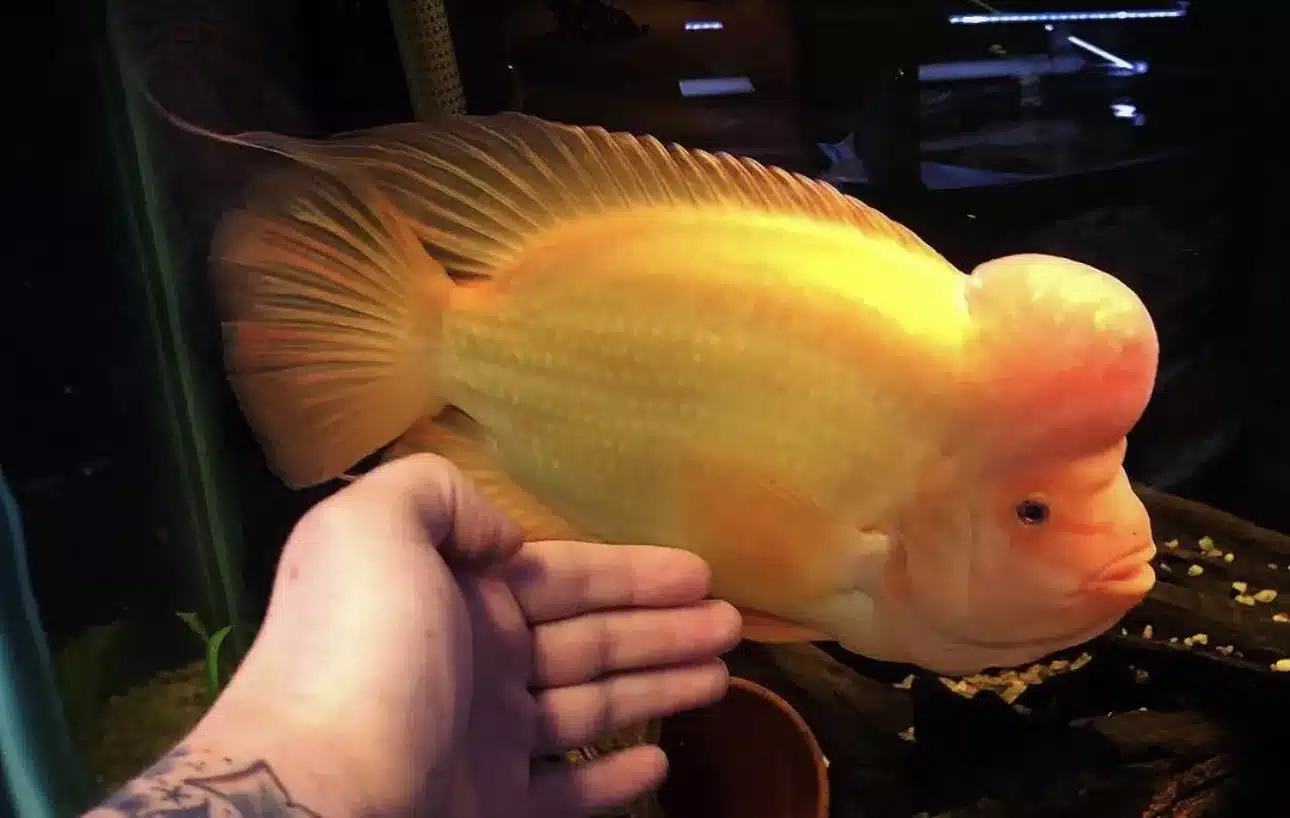
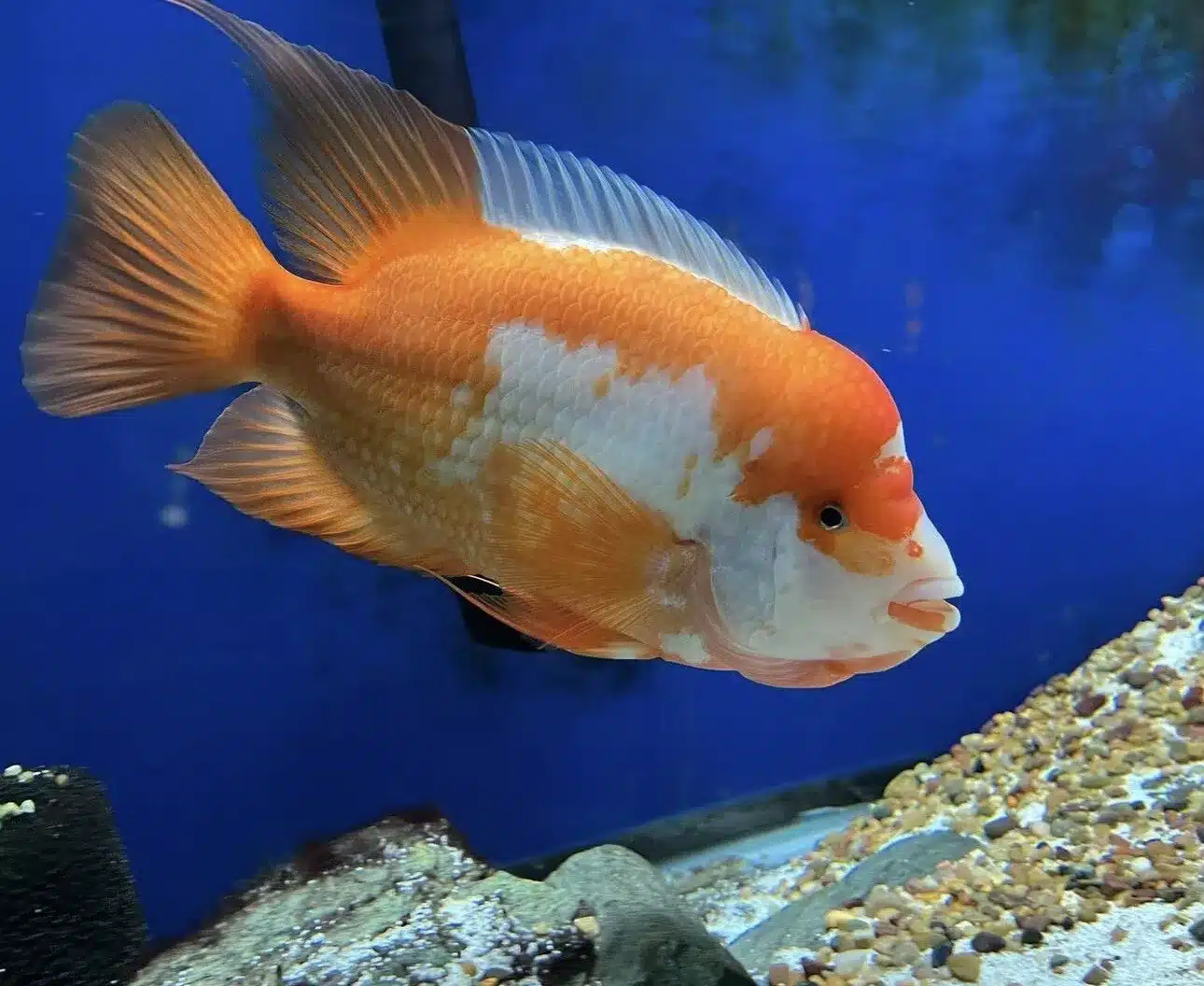
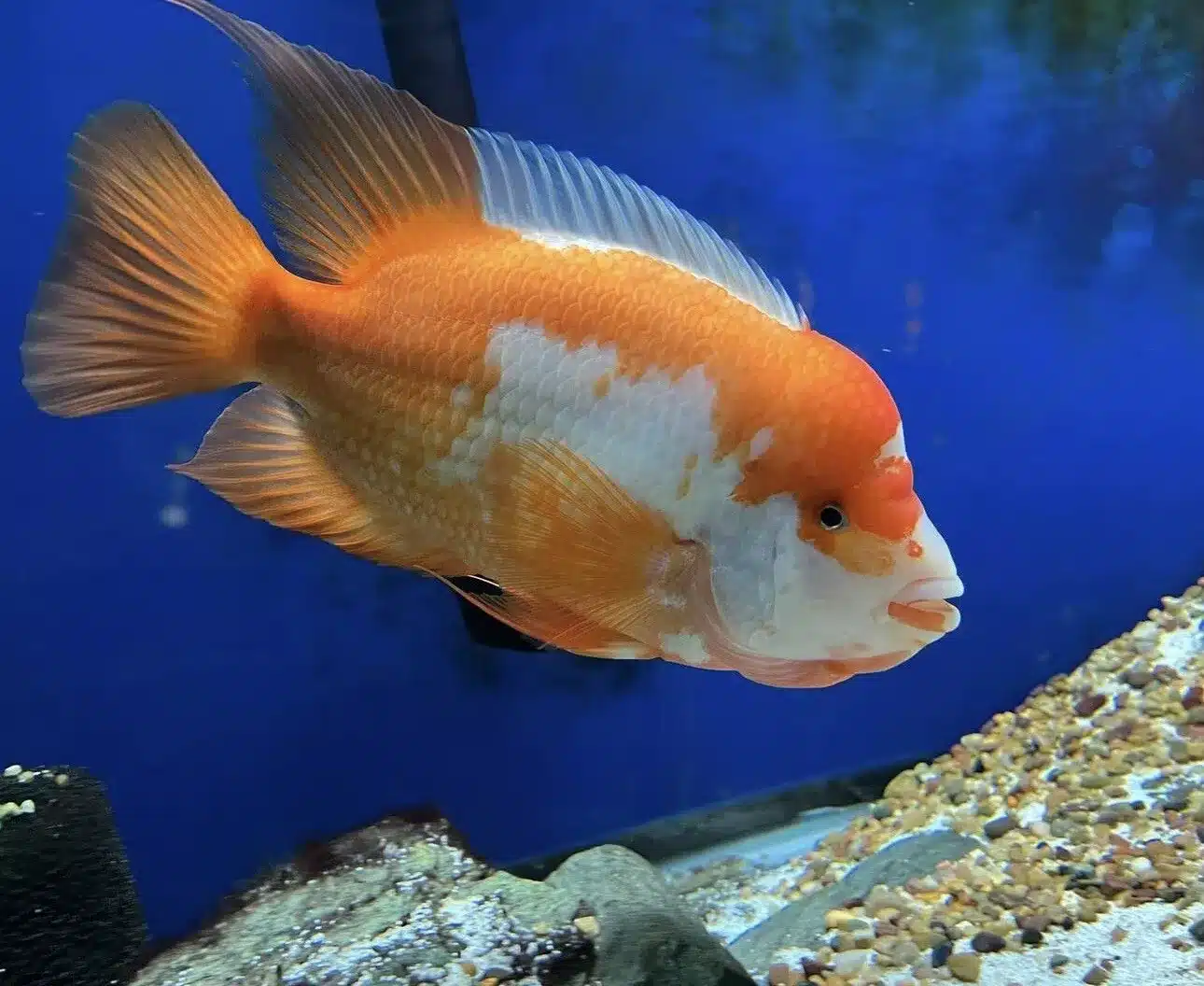
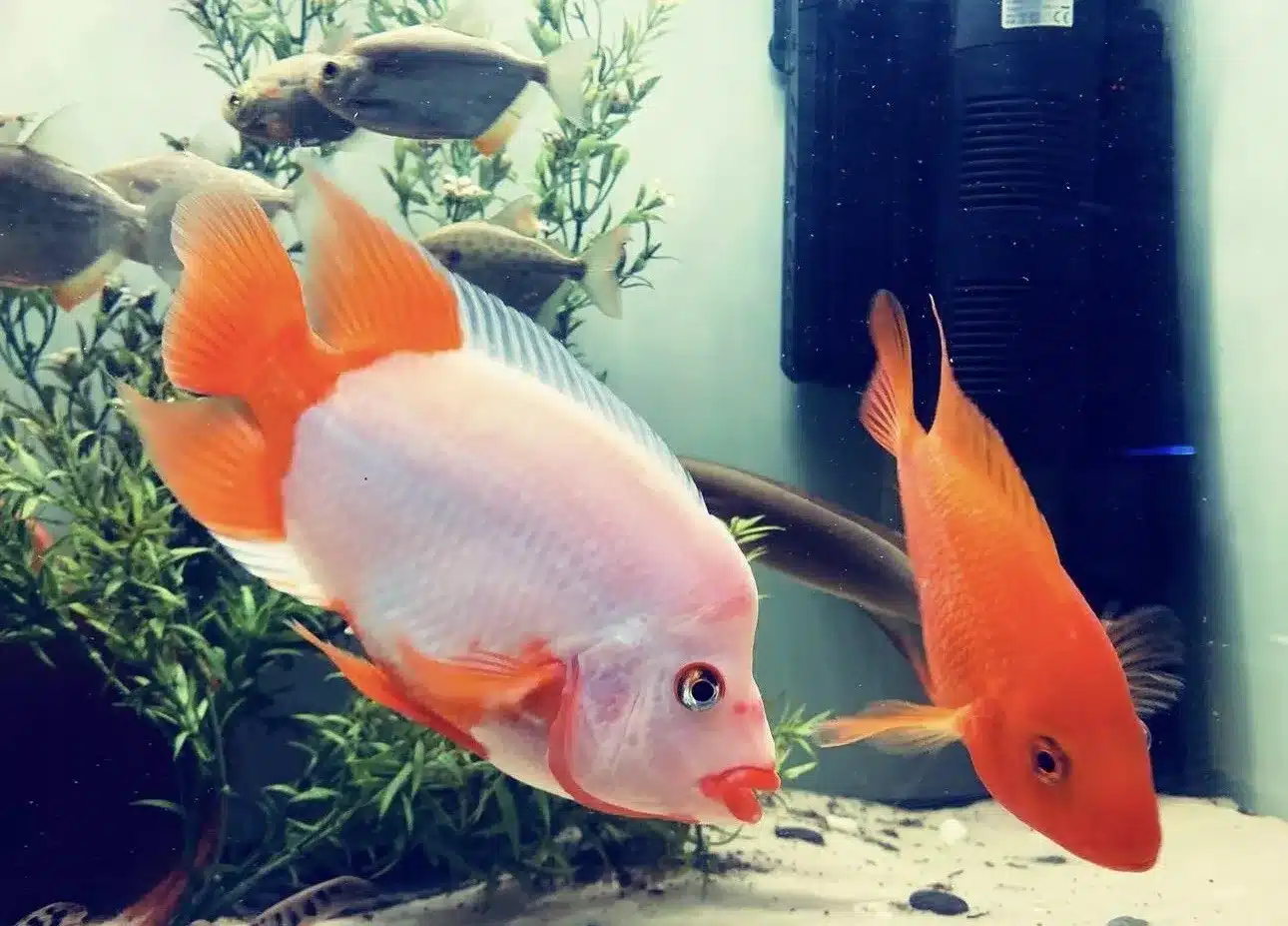
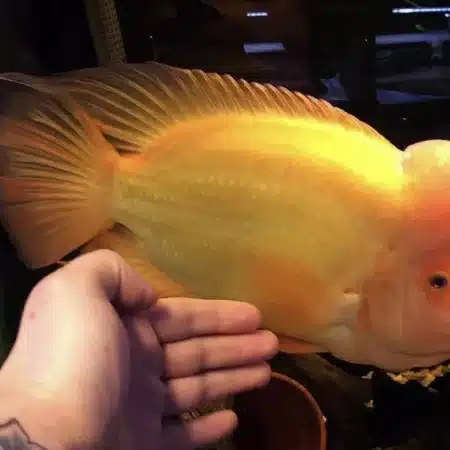
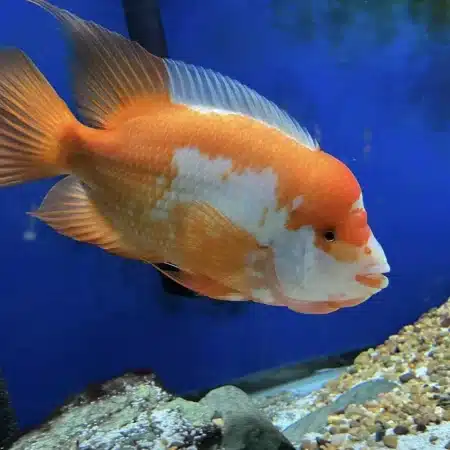
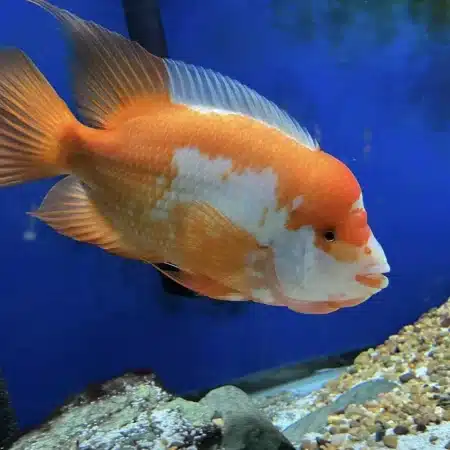
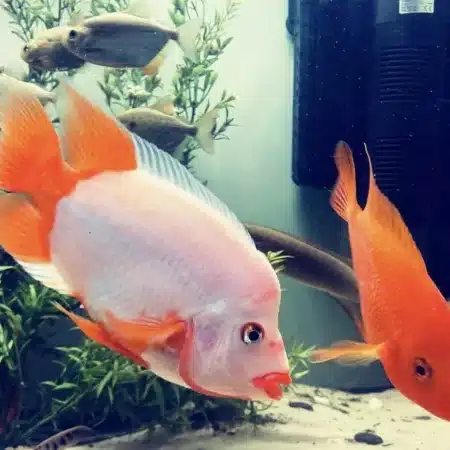
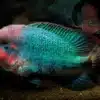
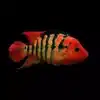








Emily Carter (verified owner) –
I recently added the Red Devil Cichlid (Amphilophus Labiatus) to my aquarium, and I couldn’t be happier! This little guy, about 5cm, has quickly become the star of the tank. His striking colors and energetic personality light up the space. I’ve kept tropical fish for over five years, and I’ve had cichlids before, but this one truly stands out.
After two weeks, he has settled in beautifully. I made sure to provide plenty of hiding spots and suitable plants, which he seems to love. I’ve noticed him being quite bold, swimming around and interacting with the other fish, which is a joy to watch. Compared to other cichlids I’ve owned, his behavior is more engaging and confident.
One minor concern is that he’s a bit territorial, so I recommend this fish for those who have a suitable setup and some experience with freshwater fish. If you’re new to the hobby, be prepared for a bit of a learning curve with his temperament. I’d highly recommend the Red Devil to anyone looking for a vibrant and charismatic pet fish. Just ensure your tank is well-established and spacious enough. I’m looking forward to watching him grow! Overall, I’m thrilled with my purchase and will definitely buy from this seller again!
Mike Thompson (verified owner) –
I recently added the Red Devil Cichlid to my aquarium, and I couldn’t be happier with my choice! After about two months of observation, this vibrant fish has not only brought life to my tank but has also become quite the character. Their striking colors are truly captivating, and they have a fascinating personality that keeps me engaged every day.
From a care perspective, I’ve found this cichlid to be relatively easy for both new aquarists and those with more experience. They thrive in a tank with plenty of hiding spots and open swimming space, which I created using rocks and driftwood. I appreciate that they require a good-sized tank (at least 30 gallons), which encourages responsible fish keeping and ensures their health. Compared to other cichlids I’ve kept, like the Oscar, I find the Red Devil’s temperament to be a bit more manageable, although they can be territorial during breeding.
I recommend this fish to anyone looking to enhance their aquarium with a beautiful and active freshwater fish. Just be mindful of their space and tank mates! Overall, a fantastic purchase that has enriched my aquarium experience!